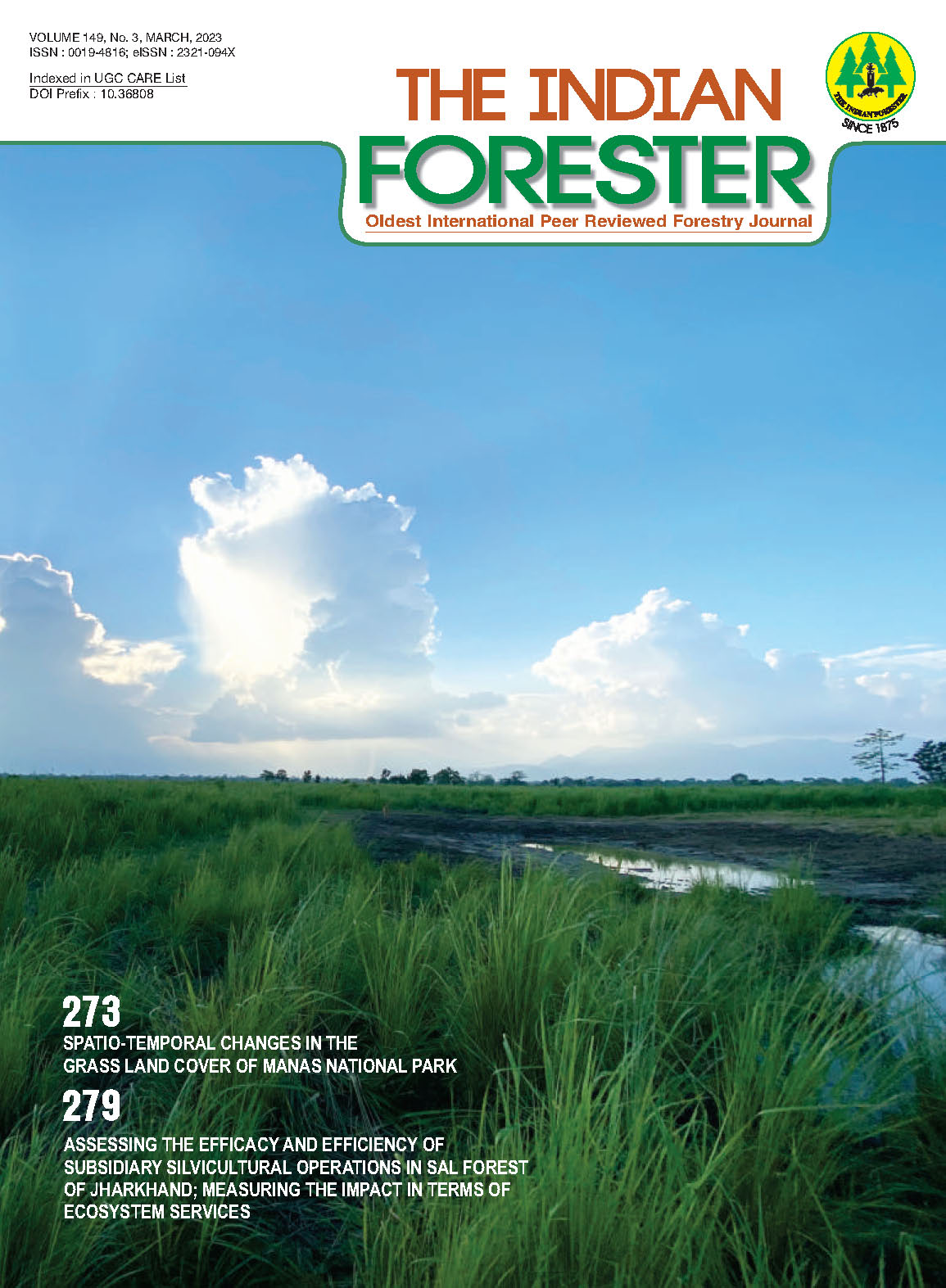Economic Contribution of Wild Edible Minor Fruits to the Forest Fringe Tribals - A Sustainable Alternative Livelihood Approach
DOI:
https://doi.org/10.36808/if/2023/v149i3/159824Keywords:
Economic Valuation, Livelihood Option, Minor Fruits, Tribal Community.Abstract
Valuation of tropical dry deciduous forests of eastern lateritic part of India is mostly based on economic appraisal of its wood stock. Occasional assessment often overlooks the economic potential of non-timber benefits like wild edible minor fruits (WEMFs) which have a wide subsistence use even for cash income. Present study deals with the ethnobotanical information, spatio-temporal distribution along with estimation of economic contribution considering annual productivity and utilizations of WEMFs in the two sampled forests of eastern lateritic part of India from where a major tribal community (Santal) gets benifit. Annual production and utilization was performed considering different factors associated to the quantum of extraction. A new comprehensive economic model was developed to estimate the net annual economic contribution per Santal family by WEMFs. A higher production peak of WEMFs in alternative year was noted along with Clump distribution and specific habitat preference. Net value of revenues - from these WEMFs was estimated to be Rs. 772.86 ± 76 family-1 year-1 which presently contributing 3.74% of their total annual income. Forests of eastern lateritic part of India have a strong potentiality to produce WEMFs that may be helpful in generation of alternative livelihood option to the local tribals through entrepreneurship development.References
Chopra K. (1993). The Value of Non-Timber Forest Products: An Estimation for Tropical Deciduous Forests in India, Economic Botany, 47(3): 251-257.
Chothe A., Patil S. and Kulkarni D.K. (2014). Unconventional wild fruits and processing in tribal area of Jawhar, Thane District, Bioscience Discovery, 5(1): 19-23.
Dorp M.V., Niemeijer R. and Offermans D. (1998). The Wealth of Forests. A Methodology for Socio - Economic Valuation of Non-timber Forest Products on a National Scale. Amsterdam; The Netherlands, AID Environment 75.
Ghosal S. (2011). Importance of non-timber forest products in native household economy, Jounnal Geography and Regional Planning, 4(3): 159-168.
Gopikumar K., Rani C., Luckins C., Babu C. and Peethambaran K. (2005). Phyto-sociological Studies of a Sacred Grove at Mannarashala, Kerala. In: Strategy for conservation of Sacred Groves (C. Kunhikannan and B. Gurudev Singh, Eds.), Coimbatore, IFGTB (ICFRE), pp. 65-71.
Goss J.D. (1996). Introduction to focus groups, Area, 28(2): 113-114.
Grix J. (2004). The Foundations of Research. Palgrave Macmillan, London.
Hooker J.D. (Ed.) (1872-1879) Flora of British India. 1-7. Secretary for State of India, London.
Jackson J.E. (2003). Biology of Apples and Pears. Cambridge University Press, New York.
Ludwig, J.A. and Reynolds, J.F. (1988). Statistical ecology: A primer on methods and computing. John Wiley and Sons, New York.
Magurran A.E. (1988). Ecological diversity and its measurement. Princeton University Press, Princeton, New Jersey.
Mahapatra A.K., Mishra S., Basak U.C. and Panda P.C. (2012). Nutrient Analysis of Some Selected Wild Edible Fruits of Deciduous Forests of India: An Explorative Study towards Non Conventional Bio-Nutrition, Advance Journal of Food Science and Technology, 4(1): 15-21.
Manna S. and Roy A. (2014). Economic contribution of wild edible mushrooms to a forest fringe ethnic community in some eastern lateritic parts of India, Journal of Forest Research, 19(1): 52-61.
Marshall C. and Rossman G.B. (1999). Designing Qualitative Research. SAGE Thousand Oaks, California.
Nayak J. and Basak U.C. (2015). Analysis of some nutritional properties in eight wild edible fruits of Odisha, India, International Journal of Current Science, 14: E 55-62.
Olsen C.S. (1998). The Trade in Medicinal and Aromatic Plants from Central Nepal to Northern India, Economic Botany, 52(3): 279-292.
Prain D. (1903). Bengal Plants. Bishen Singh and Mahendra Pal Singh, Dehradun.
Premalatha B. (2000). Semecarpus anacardium Linn. Nuts -A boon in alternative medicine, Indian journal of experimental biology, 38(12): 1177-1182.
Richards M. (1994). Towards Valuation of Forest Conservation Benefits in Developing Countries, Environmental Conservation, 21(4): 308-319.
Sinha R. and Lakra V. (2005). Wild tribal food plants of Orissa, Indian Journal of Traditional Knowledge, 4(3): 246-252.
Sundriyal M. and Sundriyal R.C. (2001). Wild edible plants of the Sikkim Himalaya: Nutritive values of selected species, Economic Botany, 55(3): 377-390.
Svarrer K. and Olsen C.S. (2008). The Economic Value of Non Timber Forest Products - A Case Study from Malaysia, Journal of Sustainable Forestry, 20(1): 17-41.
Wollenberg E. (1996). An Evaluation of Methodologies Used in Time Allocation Research. In: Gender Issues in Farming Systems Research and Extension (S. Poats, M. Scmink and A. Spring, Eds.), Boulder, Westview Press, pp. 127-147
Zar J.H. (1974). Biostatistical Analysis. Prentice-Hall, Englewood Cliffs, 620p
Downloads
Downloads
Published
How to Cite
Issue
Section
License
Unless otherwise stated, copyright or similar rights in all materials presented on the site, including graphical images, are owned by Indian Forester.





